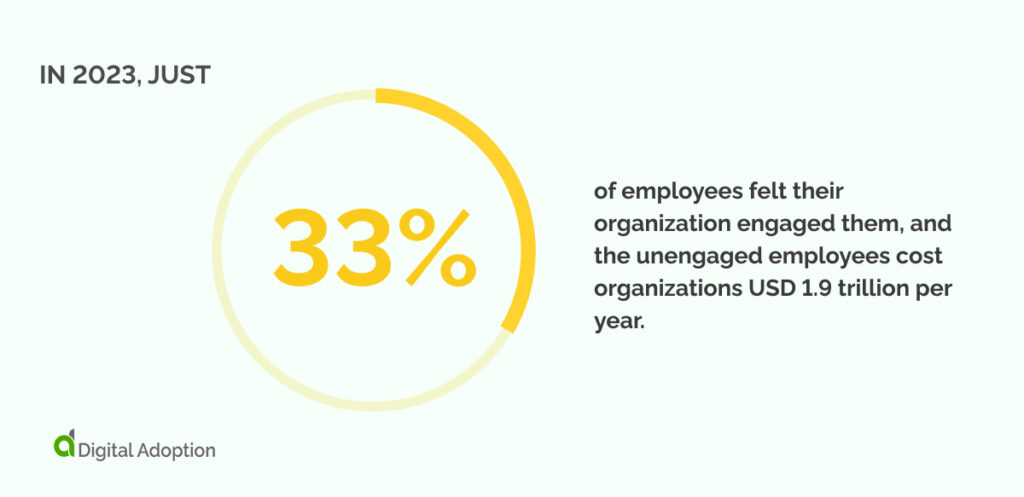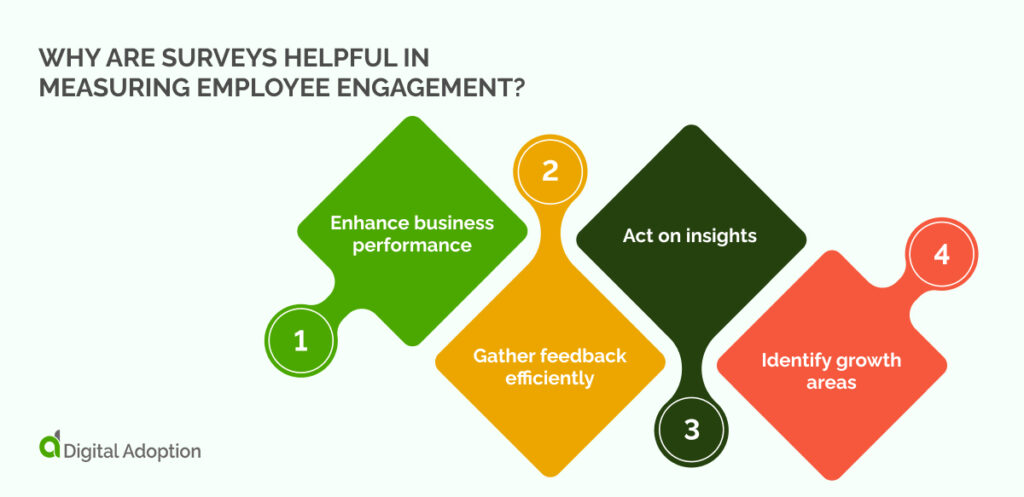From operations to workflow, the digital employee experience and high engagement drive every aspect of your organization,
Engagement is essential for staff to understand your organizational values and deliver productivity to make the company successful.
So, are you asking their views to discover how they feel about their employer, and are you considering how to make positive changes based on their feedback? You must consider surveys the key to your employee experience management efforts, from ensuring a robust onboarding to a supportive offboarding checklist.
Employee engagement surveys are vital for gathering insights into how workers view their organization, demonstrating care about their opinions.

In 2023, just 33% of employees felt their organization engaged them, and the unengaged employees cost organizations USD 1.9 trillion per year. This statistic shows how essential it is to engage your staff for their well-being, retention, and controlling waste.
Explore the sixteen best question examples in your employee engagement surveys to keep your staff switched on, motivated, and feel that their organization is willing to listen and act on their feedback, boosting employee productivity for years.
16 essential employee engagement survey questions
These sixteen examples of the best survey questions will help you get the most honest answers about how they view their organization and role.
We have also included how to act on each answer to keep your staff satisfied and supported, encouraging them to stay in your company and make it successful.
1. How do you feel being at work today?
This question delves into employees’ attitudes, fostering a deeper dialogue and showcasing company concern for their well-being. It’s crucial to discern if specific groups or roles exhibit discontent, potentially indicating underlying systemic issues.
Visual aids like emoticon scales offer a user-friendly way for employees to convey their sentiments, particularly those hesitant to articulate feelings verbally. Additionally, an optional comments section allows individuals to provide further context if desired.
How to act on the survey response
Act on employee feedback by implementing changes that align with their concerns to foster a positive work environment that values and acts on their input. Examples can be minor changes like fixing a coffee machine to more significant changes like concerns about inadequate support for new software rollouts and feedback not receiving actions.
Thanks to the AI-driven digital transformation, we live in uncertain times, and employees may have concerns about this. Take the time to discuss anxieties and address them now to avoid departures down the line.
2. Would you recommend our organization to friends and family as an employer?
As the adage suggests, satisfied customers spread the word positively, while dissatisfied ones amplify negativity, which applies even more to employees.
Your staff represents the most influential advocates or detractors when attracting new talent. Whether they actively endorse your organization to their acquaintances or caution them away provides valuable insights into overall company performance and individual employee sentiment.
How to act on the survey response
Regularly incorporating this question allows for ongoing assessment and comparison with previous survey findings and enables you to plan actions to make it more likely for staff to recommend your organization to their family friends. You can use their feedback to direct recruitment practices to increase their effectiveness.
3. Do you feel excited when you think about coming to work?
This query aims to provoke both passionate and passive responses. Enthusiastic employees share their zeal, influencing others positively. Conversely, neutral responses prompt further exploration, inviting insights on enhancing workplace excitement for less engaged individuals.
Next, analyze responses to this question by identifying factors influencing enthusiasm. Implement initiatives to enhance workplace excitement, foster a positive culture, and align organizational goals with employee motivations.
How to act on the survey response
Examples of ways to increase excitement in roles are showing appreciation with small gifts, bringing food to meetings, or changing an employee training method to suit needs better and help employees progress more quickly. Employee gamification can make work more exciting by making workflows feel like video games, including leveling up and building experience points.
4. Do you feel proud to work for our organization?
This question focuses on both employee achievements and their contribution to the organization. Proud employees reflect their accomplishments, serving as brand ambassadors to customers and acquaintances. Provide an optional comments section for those less proud to elucidate their perspective.
How to act on the survey response
Ways to increase pride at work are for managers to hold more frequent casual chats with team members, better recognition through friendly competition schemes, regularly communicate organizational value, and ask staff if they identify with them and feel they should change.
5. Are you satisfied with your benefits and compensation?
While compensation is a significant aspect of employee satisfaction, it’s not the sole determinant. Perceived inequities in pay can lead to discontent among staff. Additionally, querying about benefits reveals their significance to employees, aiding in identifying valuable offerings.
How to act on the survey response
If staff are unsatisfied, hold one-to-one meetings to discuss pay grades and how they could receive support to get promotions or give feedback on what benefits would align with their lifestyle.
6. Do you enjoy working within your team?
Team morale spreads quickly. Satisfied team members convey their appreciation to peers, fostering a positive atmosphere. Consider providing a text field for detailed responses, highlighting exceptional team members. Address any grievances regarding colleagues or supervisors by directing employees to appropriate channels for resolution.
Alignment inquiries in engagement surveys extend personal sentiments to organizational dynamics. They gauge whether employees perceive their contributions as valued and recognized by management. Strong alignment indicates motivated employees whose personal objectives align harmoniously with their role within the company.
How to act on the survey response
Where appropriate, discuss re-skilling opportunities to help them move to a different department if they would prefer. Also, consider SasS collaboration tools to help improve professional relationships.
7. Do you find meaning in your work here?
Employees who find their work meaningful exhibit more remarkable dedication and happiness. They demonstrate resilience during challenges and tend to stay loyal to the organization. Engaged employees recognize their contributions’ significance and impact on the organization’s goals.
How to act on the survey response
If staff report a lack of meaning in their work, offer a meeting where they write down how they would like to feel meaning in their role and discuss how to find similarities between these and the organizational goals. If they don’t align in any area, consider how the employee’s role could change to find meaning.
8. Does this organization’s values and vision inspire you?
This question aims to gauge employees’ alignment with your mission and objectives. Are they actively engaged, embodying organizational values to customers and peers? Some employees might be unfamiliar with your vision and values; consider providing them alongside the question or offering an option to indicate lack of familiarity.
How to act on the survey response
If the vision for your organization doesn’t inspire employees, it’s failing. Host a meeting with employees who don’t feel inspired and ask their opinion on what they would find inspirational about working for your organization, then implement these ideas into a new employee-led vision. You can also allocate vision champions to spead the vision to every department.
9. Do others provide you with recognition for your accomplishments at work?
Acknowledgment significantly boosts employee engagement, serving as its primary driver. Most individuals desire recognition and appreciation, particularly from managers and leaders, even if unspoken.
Failure to feel appreciated often prompts employees to seek recognition elsewhere. Regular acknowledgment is vital for enhancing employee appreciation and engagement.
How to act on the survey response
Team activity days and asking employees how they want to receive recognition are great ways to show you value their hard work.
10. Is your supervisor engaged in your success?
Responses to this question provide insights into managerial effectiveness and employee readiness for success. Managers significantly influence team engagement levels. Showing genuine interest in each employee’s work and career aspirations is the initial step toward fostering a leadership culture that promotes employee engagement.
How to act on the survey response
Employees need to feel their organization’s success has some benefit to them. Share profits via monthly or annual bonuses, but be careful tying this to performance, as this can hamper motivation.
11. Does this organization’s culture foster a supportive, comfortable work environment?
This question evaluates whether employees perceive the organizational culture as aligned with their objectives or at odds with them. Has your organization emphasized a genuinely inclusive and diverse culture?
How to act on the survey response
The answer to this query might unveil uncomfortable realities about your organization’s culture and its impact on the business environment. However, acknowledging these cultural challenges is the initial stride towards cultivating a culture that every employee can embrace and contribute to with pride.
As your staff to describe situations they have found comfortable and uncomfortable and adjust the workplace to reduce awkward situations and increase comfortable situations.
12. Is leadership invested in and contributing to your culture initiatives?
Your organizational culture originates from a shared mission and how leaders convey that purpose to team members and customers. Regrettably, nearly half of employees perceive leadership as minimally or not committed to enhancing company culture.
Leaders must champion cultural values to demonstrate care for employees. Open communication about company culture, including feedback on what works and what doesn’t, is essential for progress.
In 2022, 50 million Americans quit their jobs because the Covid-19 pandemic made them realize they could find better job opportunities. These numbers are now returning to pre-COVID levels, but the point remains that it doesn’t take much for staff to re-evaluate their position in a company and depart for something better.
How to act on the survey response
Culture is complex as it’s composed of thousands of individuals. It can only receive guidance. Executives cannot design it from the top down. Discuss with employees what they would like to change about their organizational culture and put the power in their hands. Then support them to achieve it.
13. Can you see yourself working here in a year?
Every month, 3.39 million Americans voluntarily resign from their jobs. Including a text field with this question allows employees to express reasons for their potential departure if they choose to do so. Asking this question can help establish why employees are considering departing and satisfy them in their role to prevent this.
How to act on the survey response
Are they disappointed they didn’t receive a promotion? Discuss career progression and employee inboarding opportunities over a period they find satisfactory.
Are they interested in pivoting to a different department? Discuss the possibility of transferring their skills to make this happen.
Do they feel they weren’t offered support during a recent employee digital transformation? Look into this, get back to them quickly about why this might have happened, and assure them that more support will be available.
There are often ways to correct the wrongs employees feel their organization has inflicted on them, and it’s essential to act on these quickly to avoid resignations and the USD 7,500 to 28,000 in costs of hiring new staff.
14. Does your work challenge and support your personal and professional development?
This question aims to gauge employees’ level of interest in their work. Avoid imposing artificial challenges instead of genuinely engaging tasks, as employees tasked with challenging work beyond their control may feel unsupported or frustrated.
How to act on the survey response
Many academic studies have shown that challenge is a human need for purpose and productivity. Ask your staff what they find challenging on a personal level and try to align their continuous professional development goals with their personal challenge needs.
15. Have you recently considered leaving this organization?
Consider reassuring employees of the anonymity of this survey or offering vague response options like “Not sure.” It’s crucial to proactively uncover the truth to address potential systemic issues, safeguarding employee productivity and morale.
How to act on the survey response
Discuss with staff at what point they considered leaving and the reasons. Consider what was happening in the organization then and what you can do now to motivate employees to remain without pressure. This activity should help them reconsider and feel their concerns are valid, making them more likely to stay.
16. What practices, processes, or tasks do you think we need to change?
This question prompts employees to offer suggestions and insights. Employee engagement notably rises when employees perceive themselves as active contributors in a responsive organization.
How to act on the survey response
Sit down with employees and ask them to detail the processes, practices, and tasks within their daily workflow. Establish what they find accessible and helpful and what you could change together.
Doing so can mean the difference between low and high productivity and avoiding departures as staff feel their work makes sense to them and they can complete tasks efficiently.
Why are surveys helpful in measuring employee engagement?

You should use employee engagement surveys to collect input directly from your staff to acquire invaluable insights that can shape your corporate ethos, enhance efficiency, and propel overall organizational triumph.
As John F. Kennedy famously said, “Conformity is the enemy of growth.” You need to let your staff feel free and autonomous to incentivize them to help their organization grow through their innovations.
It is helpful to measure employee performance through surveys for four reasons:
- Enhance business performance: Engagement correlates with increased performance, innovation, and overall business success.
- Gather feedback efficiently: Surveys capture widespread employee sentiment, offering insights from the collective rather than a vocal minority.
- Act on insights: Internal feedback channels prevent negative external reviews, enabling agile improvements in culture and employee satisfaction.
- Identify growth areas: Surveys pinpoint improvement opportunities, safeguard productivity, foster a motivated workforce, and promote retention.
Consider these reasons when building your employee engagement surveys to ensure you hit these aims and optimize your investment. Doing so should result in the outcomes of authentic employee experience capture you can use to benefit your organization and workforce by acting on the experiences you collect.
Align surveys with post-survey action campaigns
Asking questions that appeal to emotions will help you establish precisely what employees feel about their role in your organization and will be a great starting point for acting on this feedback.
Once you have collected all the feedback, visibly act on it. Launch a post-survey action campaign that creates a buzz and gets people talking.
When people see that you act on their feedback and it’s not just a superficial exercise, they will communicate more openly. The culture, processes, and revenue will be driven by employees, with employee retention and innovation at an all-time high for less waste and higher profits.

 FACT CHECKED
FACT CHECKED







